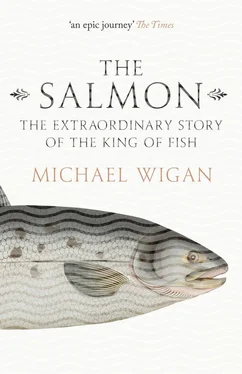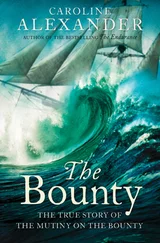Celtic Voyager and two other research vessels embarked on their exploratory fishing trips in a world being re-drawn by dynamic flux.
Anxiety about the Atlantic salmon was sufficiently syncopated and international to produce the SALSEA programme. Although salmon smolts were the tools, the programme, lasting over three years from 2008, was designed to advance the understanding of ocean ecology and fish genetics. The authors even talk about hopes that they have provided invaluable data for ‘the future ecosystem-based management of the oceans’. Big aims.
To catch these very small fish in a large piece of sea they adapted a standard small trawl for smolt capture. A small-mesh net was pulled on two side ropes and kept on the surface by large floats on each side. At the ‘cod-end’, or last compartment in a narrowing cone-shaped net, was the fish ‘box’ accumulating smolts. The smolt trawl was towed in arcs at speeds of three to five knots, anything from 150 to 400 metres from the mother ship. It was 155 metres long with a mouth forty by ten metres. The main thing was – it worked.
Quantitative results varied by region. The report cites one case where 233 trawls netted 1,728 smolts and 53 adult salmon, at a rate of 3.4 fish per trawl. This trawl had hit a migration ‘pathway’.
The long-awaited paper, which included data collection from as far back as 1999, was published in January 2012. Authors Jens Christian Holst and Ken Whelan warn that owing to cost no such programme is likely to be done again. So we should heed what they discovered.
The location of smolts was closely linked to ocean currents. Differences in temperature and salt content change the density of seawater, which in turn drives global ocean circulation through the medium of currents. The young salmon use currents as escalators. They ride them for propulsion and add to this their swimming power. Recovered tagged fish showed that smolts’ swimming power was often equal to the speed of the ocean currents. They may be small but they are powerful.
Climate variability also affected where they went. Oceanic circulation round Scotland and the North Sea is anti-clockwise. It is also driven by winds, especially between March and May. As the climate alters, these winds have been strengthening and this affects marine growth and fish travelling in the upper layers, like smolts.
Smolts’ growth rate, as measured by SALSEA, is prodigious, fairly justifying the description ‘explosive’. Each day they might grow 0.6 per cent of their body length. At the southerly edge of Atlantic salmon range smolt survival is worst. Whether the young salmon were leaving the River Loire Allier in northern France and heading westwards round the Atlantic coast of Ireland to find feeding midway between Iceland and Norway in the Norwegian Sea, or leaving north-west Spain and negotiating the English Channel, southerly stocks struggled more. The impoverished Allier has only a bare-bones population of 500–1000 breeding salmon to start with, and the Spanish rivers are similar.
Norwegian and Russian young salmon, with less far to go, and feeding further north, do better.
When travelling off Norway Europe’s little silver fish meticulously follow the shelf-edge between the shallow coastal ledge and the deeps. The shelves form shallow-water skirts off the landmasses all round the North Atlantic where salmon winter. They differ from deep drop-offs, more characteristic of volcanic landmasses. The salmon’s landmasses have a glacial origin, shelving into the sea as glaciers turned to water. Why the smolts tracked the shelf-edge can be guessed at, how they followed an invisible fault-line underneath them is a mystery.
Richard Shelton was one of the scientists working on the early phases of research and he puzzled over this. How could the fish so accurately follow this shelf? Temperature, salinity and depth were tested for roles as routeing guides and none of them seemed to fit. In their lateral line, or the line running mid-body from end to end, salmon harbour the magnetic oxide of iron called magnetite. One possibility Shelton considered was that smolts were orienteering by the Earth’s magnetic field. This remains conjectural. But stick to the shelf-edge they did. This edge lies about halfway to Iceland. Knowing where they are is a first step to protecting them.
When they reached a projecting seabed north of Iceland called the Voering Plateau, our smolts ceased linear movement and dispersed in big gyres. In the Norwegian Sea and west and east of Greenland they feed and grow at what Shelton describes as, ‘rates rivalled by few other cold-blooded creatures’.
What was their pattern when moving? Trawling results suggested loose shoals of 100–700. There was no evidence of very large-scale shoaling behaviour, which was mildly surprising. So the canny scientists put closed-circuit cameras in the net-end at right angles to the direction of towing, to view better what was being caught.
The observers saw no huge fish agglomerations being gathered in the wings of the net, rather smolts ‘sneaking about’ as Shelton put it, in ones and twos. At night smolts were hard to find, and researchers reckoned that nocturnally they must dive deeper than the ten-metre-deep band they occupied by day. But why? Most fish rise in the so-called ‘water-column’ at night, as darkness affords safety from above. Behaving contrarily, diving smolts must do so for food. But what food? Or what improbable night-time threat are they escaping nearer the surface? Answers breed questions. The salmon’s mysterious behaviour has caused it to be dubbed ‘the oceanographer’s fish’.
The northwards drift of prey species sticking to their northwards-shifting temperature bands influences smolt locations. The team found that the smolts which reached western Greenland seas and settled north-west of Iceland, staying longer at sea and returning to the UK as hugely bigger multi-sea winter fish, were faring well.
The ability to track both regional and river-specific stocks of smolts at sea is new. Because the experiment’s focus was on fish from Europe’s main salmon rivers, the great majority of net captures were successfully ‘assigned’ to their river of origin. It is part of a wider knowledge-picture, where the factual fog is clearing over all migratory routes and behaviour. Microchip and tagging technology, along with a technique involving bouncing signals off satellites, have revolutionised knowledge about migrating creatures. The migratory wading bird, the woodcock, is the next in line for a tracking research programme. Across the natural world years of speculation are being replaced with firmer data.
The salmon fishing writer Richard Waddington devoted many pages of his 1947 book Salmon Fishing: A New Philosophy to a laboriously articulated theory that wintering salmon positioned themselves in the mid-Atlantic in order to intercept common eels migrating as elvers or ‘glass eels’ from the Sargasso Sea off eastern central America. Salmon swam with these easterly migrations of juvenile common eels, he surmised, being sustained and fattened by them all the way back to their growing zones in the freshwaters of UK and Europe. It was somehow a beguiling idea.
The author died long ago, but depending on circumstances in his afterlife he may now have the chance to reconsider and chide himself for those errant thought processes. Knowledge is a grand corrective.
Knowledge was meant to be a defining feature too of the revered Scottish ecology writer, the late Frank Fraser Darling. But when it came to salmon he stumbled. Fraser Darling wrote that the fish that ascend rivers early spawn at the bottom end, and the late-season runners go to the top. In fact it is the other way round, which is why today’s efforts to resuscitate the spring salmon, assuming that like breed like, take hatchery fish from the upper parts of rivers, not the bottom end. The top reaches are where the springers are.
Читать дальше












